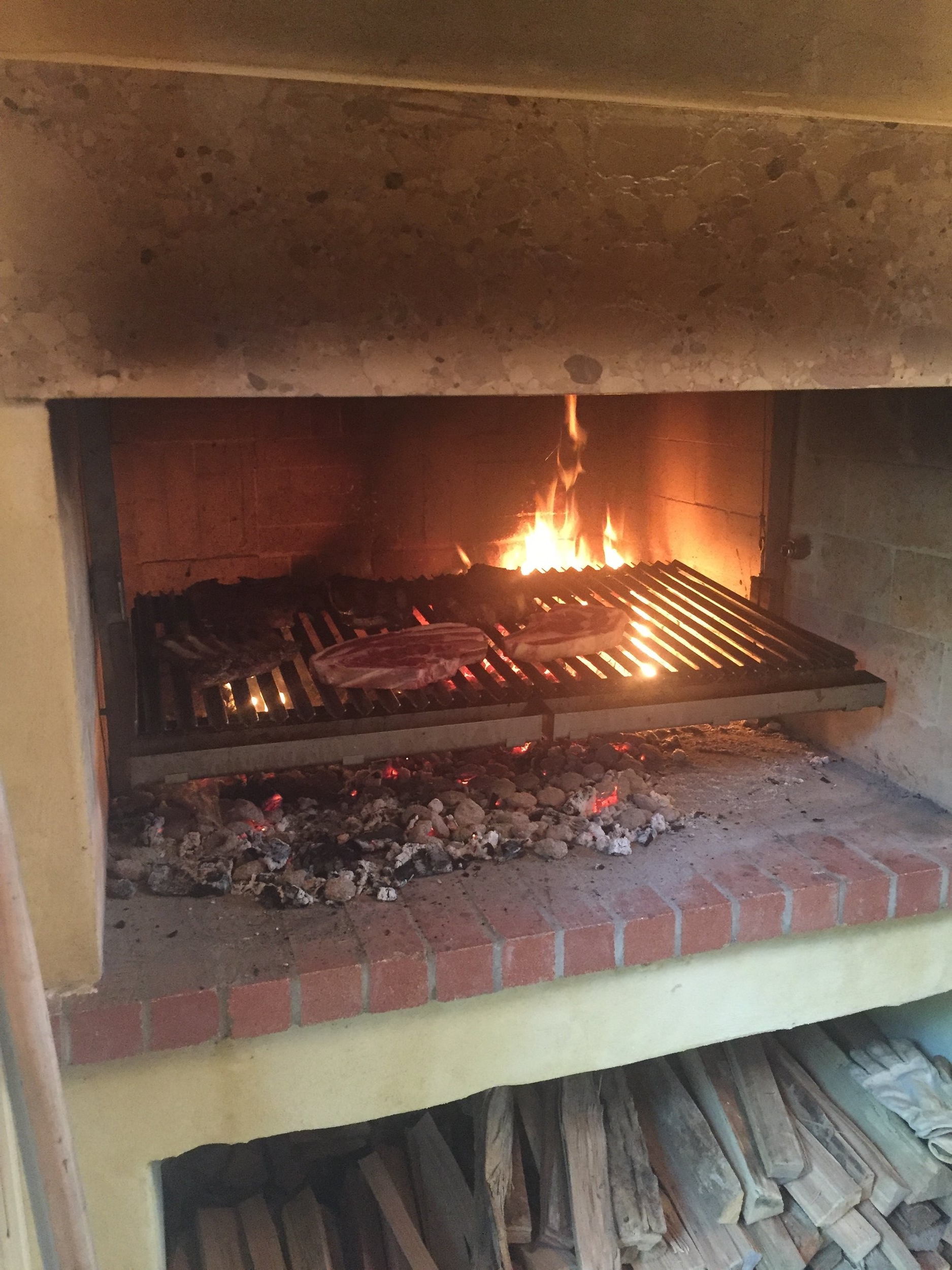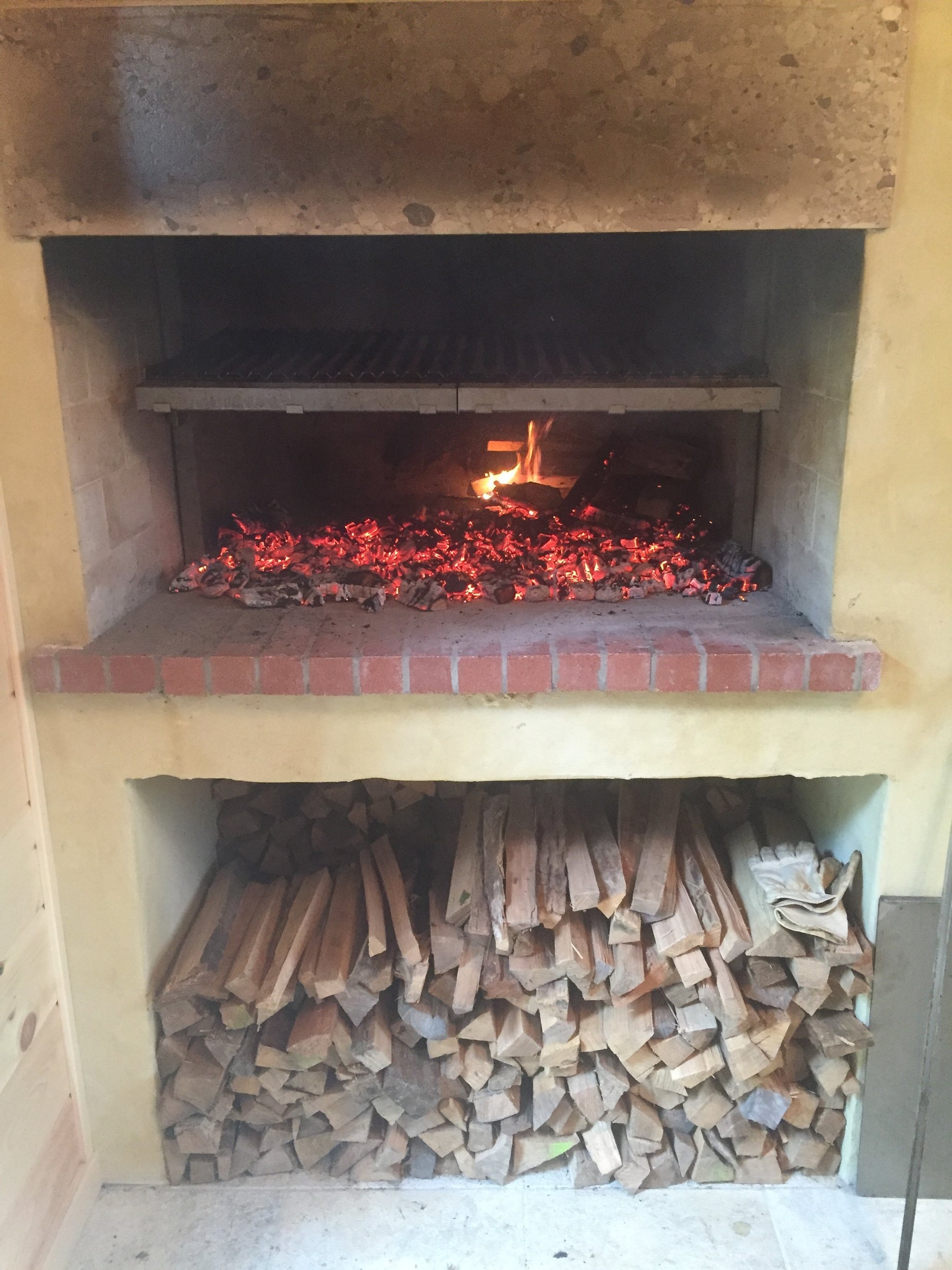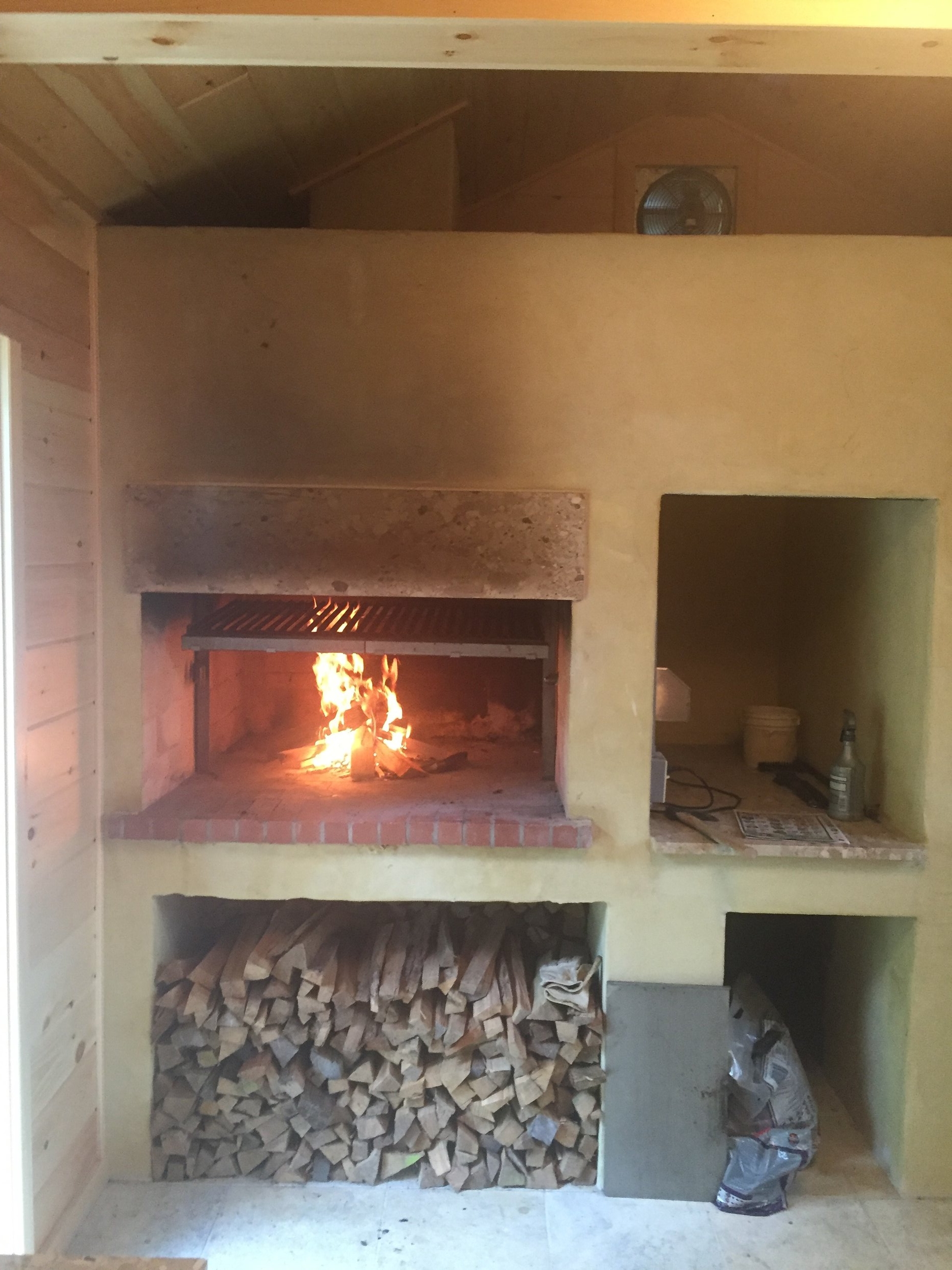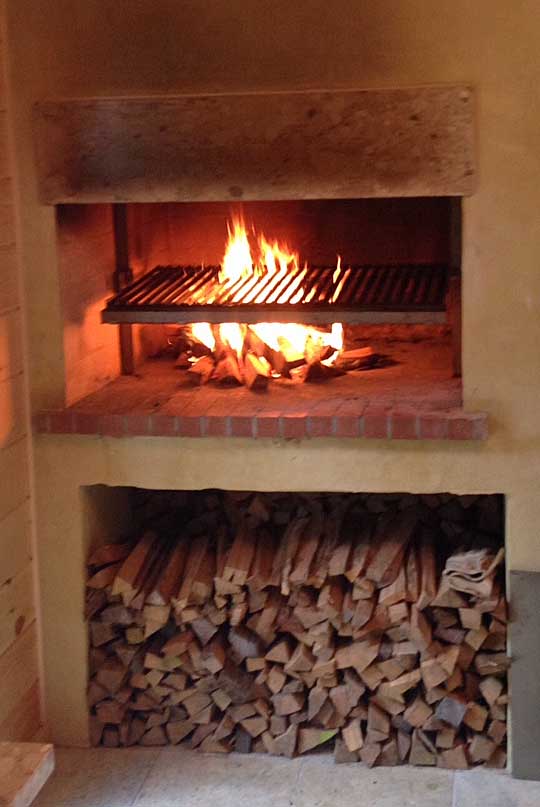Gaucho Insert - Ontario, Canada
All the way from Ontario, Canada, we have this awesome Gaucho installation. This beautiful set up features a brasero and rotisserie options, plus a thru-wall extension, so the owner can control everything with ease!
Want to be featured on our blog? Send in photos of your own set up!
Gaucho Insert - upstate New York
Check out this beautiful indoor installation of a Gaucho Insert in a custom built indoor kitchen/cooking area. Look at all that wood!
Want to be featured? Send us your photos!
Bannock - Traditional Campfire Bread
Try out this tasty and fun traditional campfire bread, just in time for the holidays!
Bannock- Campfire Bread
Serves 8 to 10
3 cups all-purpose flour
⅓ cup brown sugar
2 tsp. baking powder
1 tsp ground ginger
½ tsp ground cinnamon
¼ tsp ground all spice
¼ tsp ground nutmeg
⅛ tsp ground cloves
½ tsp. kosher salt
2 Tbsp. canola oil
1 cup water; more as needed
In a large bowl, combine the flour, baking powder, and salt. Work in the oil until well combined. Slowly add the water until a thick, sticky dough forms, adding more water as needed 1 Tbsp. at a time.
Roll the dough into a ball and pat down until 1 inch thick and about 6 inches in diameter. Place on oiled griddle pan. Cook, flipping occasionally, until a thick crust forms all over and there are dark spots on the surface, about 20 minutes.
Thanksgiving on the Grill Part 2 - The Sides
Join Chef Julie Hernandez-Roberts as she prepares the sides for our delicious Thanksgiving Feast.
Thanksgiving on the Grill Part 1 - The Turkey
Join Chef Julie Hernandez-Roberts for the first episode of The Gaucho Grills Show, as she grills up some Turkey Legs and Fire Kissed Cranberry Sauce
Basting Meat with Salmuera in Argentine Cooking
When we talk about Argentine cooking on this blog, we often make the point that there isn’t a lot of seasoning in play in many of the recipes we share.
Often, the only spice at work in these dishes is the most basic and essential one there is: salt.
Today, we’re going to look at a new element of Argentine cooking called salmuera. Salmuera simply means “brine,” or a highly-concentrated solution of salt in water. Unlike regular salt, this brine won’t toughen your meats.
When we talk about Argentine cooking on this blog, we often make the point that there isn’t a lot of seasoning in play in many of the recipes we share.
Often, the only spice at work in these dishes is the most basic and essential one there is: salt.
Today, we’re going to look at a new element of Argentine cooking called salmuera. Salmuera simply means “brine,” or a highly-concentrated solution of salt in water. Unlike regular salt, this brine won’t toughen your meats.
Argentine Salmuera
You can use salmuera as a marinade before you cook, or as a condiment when your meat comes off the grill. Best of all, you can whip up a batch in just a few minutes. You’ll need:
5 ounces virgin olive oil
5 ounces white vinegar
1 fresh garlic, all cloves peeled and sliced
2 bay leaves
2 sliced green hot peppers
1 tsp coarse salt
1 tsp. ground black pepper
½ sliced white onion
When you’ve gathered and prepared these ingredients, put them in a blender or food processor and process until completely blended.
Almond Salmuera
If you’d like to take salmuera to another level, you can try this Food & Wine recipe for grilled pork chops with an almond salmuera. You’ll need:
½ cup extra-virgin olive oil
¼ cup (plus 2 tsp. sherry vinegar)
1 minced shallot
1 minced garlic clove
Kosher salt
Pepper
¼ cup chopped marcona almonds
1 tsp. minced chives
1 tsp. minced parsley
1 tsp. minced mint
1 tsp. minced cilantro
Canola oil for brushing
Four 8-ounce bone-in pork chops, cut one inch thick
Sea salt for finishing
To prepare:
Whisk ¼ cup of olive oil and two tablespoons of vinegar with the shallot, garlic, a tablespoon of kosher salt, a teaspoon of pepper and a cup of water. Stir in the almonds, parsley, chives, mint and cilantro.
Use a small bowl to whisk the remaining olive oil and vinegar with two tablespoons of pepper and ¼ cup of water. You now have two bowls of salmuera: regular and almond.
Grill the pork on your Gaucho Grill, basting frequently with the first bowl of salmuera until the meat is brown. You should grill the pork six to seven minutes on each side.
Remove the pork from the grill and baste it with the almond salmuera.
Ready to add salmuera to your Argentine cooking repertoire? The best way to do that is a Gaucho Grill. Visit our website today to find a grill model that works for you. Enjoy!
Tips for Grilling Fish on Your Gaucho Grill
Compared to sausage, steaks and chicken, fish can seem like a minor league player trying to compete against a team of all-stars.
And yes, flounder cooked in a pan in your kitchen is no match for a nice thick steak at a backyard barbecue. But put fish on your Gaucho Grill, and all bets are off. Grilling brings out the best in fish. Here are a few tips to get started.
Compared to sausage, steaks and chicken, fish can seem like a minor league player trying to compete against a team of all-stars.
And yes, flounder cooked in a pan in your kitchen is no match for a nice thick steak at a backyard barbecue. But put fish on your Gaucho Grill, and all bets are off. Grilling brings out the best in fish. Here are a few tips to get started.
1. Choose the right fish
Not every fish is great for grilling. Tender varieties, such as catfish, flounder and tilapia, are too flaky, and can fall apart. You can cook them on the grill them using foil or a wire basket, but you’d be better off saving them for your kitchen.
Instead, look for thicker steaks: swordfish, tuna, salmon or mahi-mahi. If you’re feeling adventurous, try whole fish such as snapper, trout or bass.
2. Should I marinate?
It depends on the fish. Thick cuts like tuna and swordfish really come alive when marinated. All you’ll need is a blend of oil, vinegar and spices to turn these fishes from dry to juicy.
When you’re cooking an oily fish such as salmon or bluefish, dry thoroughly with paper towels, then sear or grill them with just a little butter or oil. Add sauce or other condiments just before or after the fish is finished on the grill.
3. How can I tell it’s done?
If you’re cooking a whole fish, the rule of thumb is to cook it 10 minutes for each inch of thickness. For a smaller piece of fish, go with eight minutes per inch of thickness.
Check the fish two minutes before you expect it to be done, and remember that fish – like steak – continues cooking for a few minutes after it leaves the grill.
If you’re ready to get started, here’s a recipe for Argentinian salmon with cilantro peanut sauce that you can prepare on your Gaucho Grill.
Ingredients
For the salmon:
2-4 salmon fillets
½ tsp smoked paprika
½ tsp cumin
½ tsp salt
½ tsp onion powder
¼ tsp black pepper
A pinch of red pepper flakes
For the sauce:
1 cup fresh cilantro
½ cup lightly salted dry roast peanuts
1 tsp Dijon mustard
1 teaspoon sherry vinegar
¼ cup olive oil
Pinch of salt and pepper
Directions
Fire up your grill and let the coals turn grey. Use a small bowl to mix the salt, pepper, paprika, cumin, and onion powder. Sprinkle this over your fish.
Put all the sauce ingredients other than the olive oil in a blender and food processer and puree for 30 seconds. Slowly drizzle in the olive oil with the blender running. Place the sauce in the boil for later.
Put the fish on the grill, flesh side down and cook for four minutes. Gently flip the fish and cook for another three to five minutes, depending on whether you want it medium rare or medium.
Remove the fish from the grill, put it on a plate or serving platter, and spoon the sauce onto each fillet.
Is fish a regular menu item at your house? A Gaucho Grill can bring out its flavor. Visit our website today to find a grill model that’s right for you.













